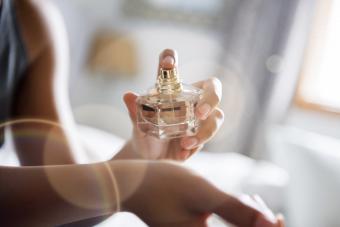
Artificial nails are the answer for broken nails, special occasions, and whenever you have a yearning for an instant set of beautiful nails. The original false nails of the 1930s have come a long way. Today the sleek, sophisticated look of false nails may be hard to differentiate from natural ones.
Four Artificial Nail Options
There are several different types of artificial nails, including acrylic, wraps, gel, and press-on nails. Some salons may have specialty nail applications as well, such as "Diamond Dust" nails. They each have different compositions, techniques, and costs involved. Although fake nails may stand up to a bit more abuse than natural nails, it's still important to treat your nails right. This means proper hand and nail care, including not using your fingernails as tools.
Acrylic Nails

Acrylic nails are one of the most popular types and are a standard available in most nail salons. After the nail is slightly roughened, chemicals are applied to form the acrylic nail. First, a liquid compound, a monomer, is applied to the nail, followed by a polymer powder. Once the chemicals are applied and dried, they form an elongated nail that can be shaped into the desired length and style. Acrylic nails can last about two weeks before needing filled.
Pros:
- These nails are widely available.
- If removed properly, they may not be very damaging to the natural nail.
- One of the longest lasting and most durable types of artificial nails.
- One of the most affordable methods.
Cons:
- There is a possibility of nails being weakened or damaged from the filing prior to application.
- If not properly applied, they can appear thick and unnatural.
- Yellowing or fungal infection is possible if nails are not properly maintained and water becomes trapped under the nails.
Gel Nails
Gel nails are formed by applying a premixed, liquid chemical gel which is then set under a UV lamp. The heat and light "cure" the nails so they can be shaped and styled as desired. Non-UV gels are formed by an additional chemical activator over the gel.
Pros:
- Many consider gel nails more natural looking.
- Application does not involve as many fumes and odors as acrylics.
- Involves less damage to natural nail.
- Clear, shiny, non-yellowing finish.
Cons:
- Usually more expensive than acrylics.
- can be expensive to maintain.
- Cannot be removed by chemical means; they must grow out and be filed down for removal.
Wraps
Nail wraps are often used as the method of choice for repairing broken fingernails or nail tips. They are also used for nail extensions and to strengthen nail tips. Fine layers, typically of silk, linen, tissue, or fiber, are pre-shaped and attached to the nail using a nail glue.
Pros:
- Does not cause much damage to the natural nails.
- Excellent method for nail repair.
- Low maintenance.
Cons:
- May not withstand as much wear as other types of artificial nails.
- Linen is a stronger wrap, but also has a thicker and less natural appearance.
- The nails aren't removed by chemical; they must grow out and reapplied.
Press-Ons
Not a typically found in nail salons, press-on nails are a "quick-fix" artificial nail solution. They can be found in virtually any department or drugstore in a variety of colors, shapes, and sizes. They adhere to the nail by a type of two-sided tape that sticks to both the false nail and the nail plate.
Pros:
- Inexpensive.
- Quick, and easy to apply.
- Ideal for a quick solution when you need great nails and no time to go to the salon.
Cons:
- Very temporary.
- Withstand little pressure or wear.
- May look obviously fake if closely inspected.
Salons and Care
Artificial nails need to be treated with care. Don't use them as tools, scrape, pick, or pull things with them. Make sure to get the necessary fills as recommended by you nail technician to keep them properly attached.
The FDA recommends keeping false nails on for no longer than 3 months to prevent infections. When choosing a salon, make sure you choose a professional establishment that adheres to sanitation and safety guidelines. You might also want to verify technicians have had the proper training, as improperly applied nails can cause severe damage.
Applying Nails at Home
Department stores, beauty supply stores, and Internet retailers offer a wealth of excellent nail supplies for home application. While most beauty experts concur that going to the salon is the best alternative, applying nails yourself can save time and money -- precious resources for many women who want the benefit if beautiful nails.
Make sure you have the all the proper equipment and proper instructions for nail application before you begin. Since there the techniques for applying nails vary, it might help to review nail application tutorials or tips pages, like HookedonNails.com, for help.







